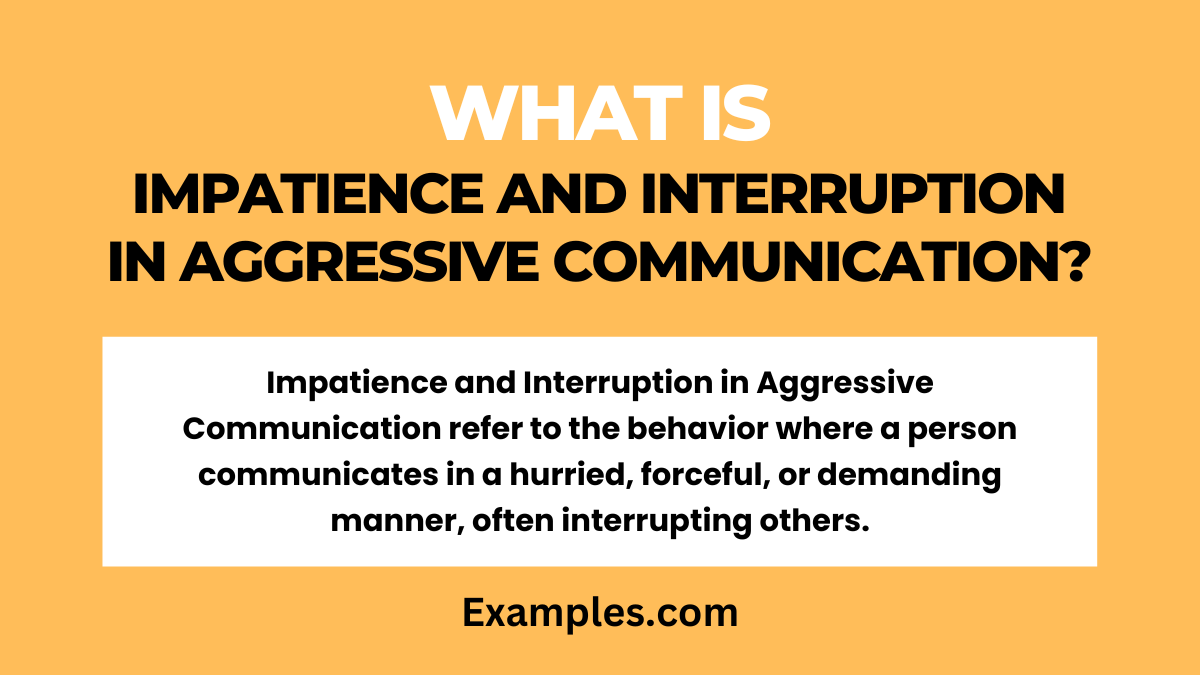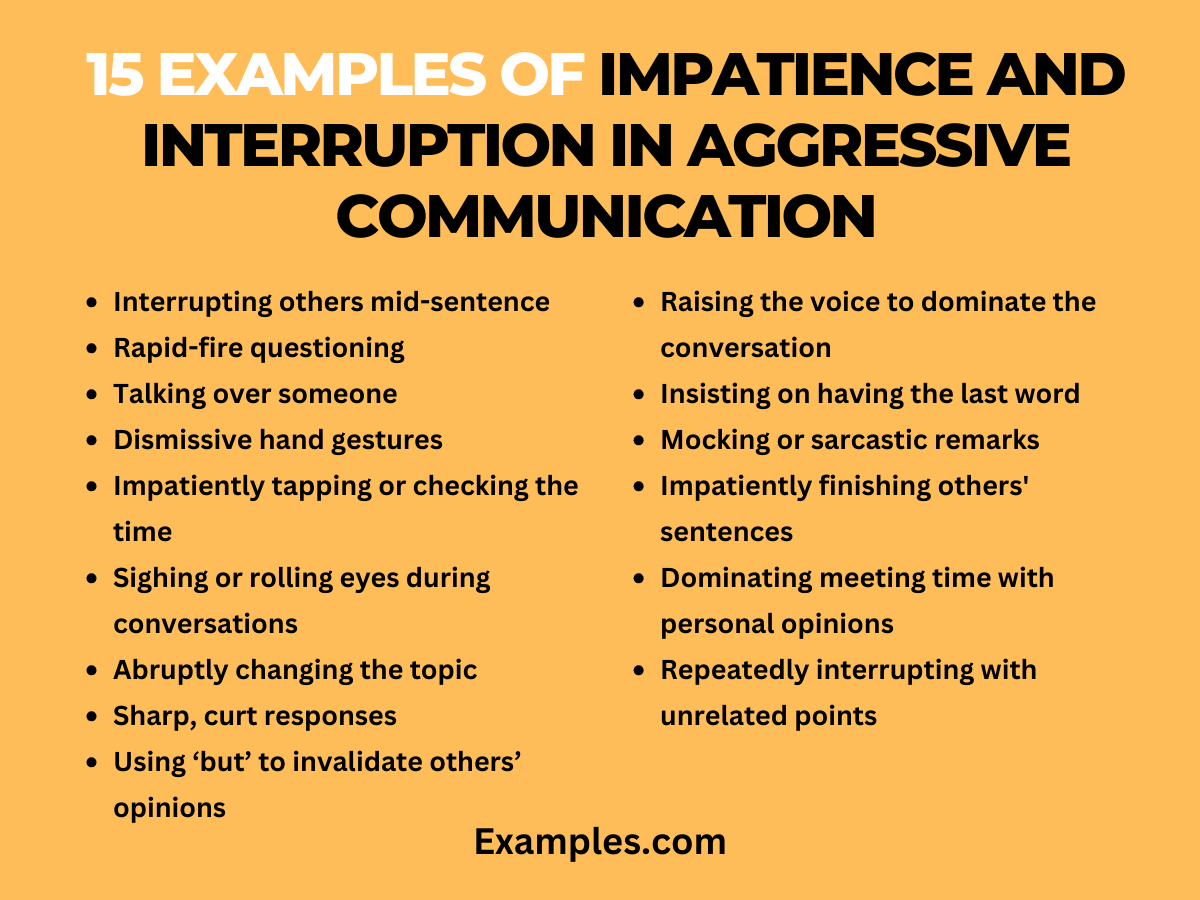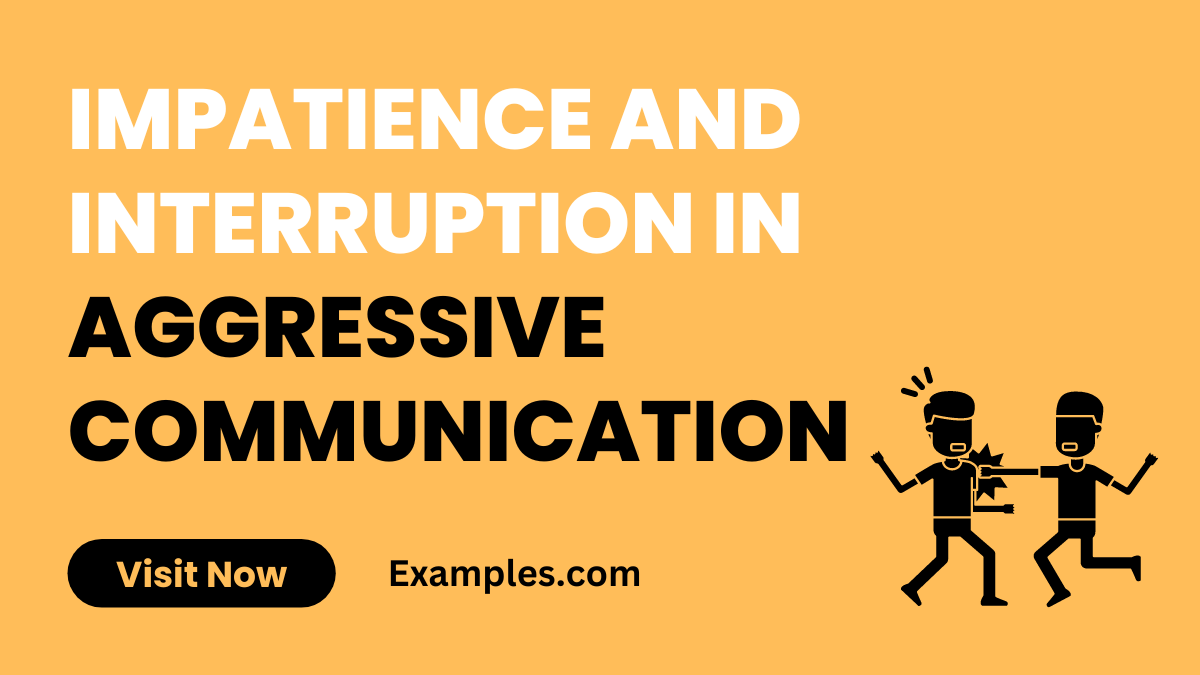Impatience and Interruption in Aggressive Communication
This comprehensive guide delves into the challenging aspects of Impatience and Interruption in Aggressive Communication, providing insights and practical solutions. Focusing on real-world scenarios, including Intercultural Communication Examples, this guide helps you understand and navigate the complexities of aggressive communication styles. Ideal for professionals and individuals alike, it offers sentence examples and strategies to effectively manage and mitigate impatience and interruptions in various communication settings.
What is Impatience and Interruption in Aggressive Communication?

Impatience and Interruption in Aggressive Communication refer to the behavior where a person communicates in a hurried, forceful, or demanding manner, often interrupting others. This type of communication is characterized by a lack of patience to listen, quick interruptions, and a tendency to dominate the conversation, usually in a confrontational or hostile tone. It can hinder effective dialogue and create a negative communication environment.
15 Examples of Impatience and Interruption in Aggressive Communication
In aggressive communication, impatience and interruption manifest in various forms, often hindering effective dialogue and collaboration. This guide presents 20 distinct examples, each illustrating a specific scenario where these behaviors occur. Understanding these examples is crucial for recognizing and addressing aggressive communication patterns, whether in the workplace, personal relationships, or Intercultural Communication settings.

- Interrupting others mid-sentence: A team leader consistently cuts off team members while they are speaking, not allowing them to finish their thoughts.
- Rapid-fire questioning: Bombarding someone with questions without giving them time to answer each one fully.
- Talking over someone: In a meeting, one person starts speaking louder while another is still talking, effectively drowning them out.
- Dismissive hand gestures: Using hand movements to dismiss or belittle someone’s contributions in a discussion.
- Impatiently tapping or checking the time: Showing visible signs of impatience, like clock-watching, during someone else’s presentation.
- Sighing or rolling eyes during conversations: Non-verbal cues indicating disinterest or disdain while others are speaking.
- Abruptly changing the topic: Shifting the conversation to a different topic abruptly without acknowledging the current speaker’s point.
- Sharp, curt responses: Replying in a terse or brusque manner, indicating impatience or irritation.
- Using ‘but’ to invalidate others’ opinions: Starting sentences with “but” to immediately counter or dismiss what was just said.
- Raising the voice to dominate the conversation: Increasing volume to overpower others’ voices and take control of the discussion.
- Insisting on having the last word: Always needing to respond last to assert dominance in the conversation.
- Mocking or sarcastic remarks: Employing sarcasm to undermine or belittle others’ contributions.
- Impatiently finishing others’ sentences: Completing someone else’s sentence in a rush to move the conversation along.
- Dominating meeting time with personal opinions: Taking up excessive time expressing personal views, leaving little room for others.
- Repeatedly interrupting with unrelated points: Continuously bringing up off-topic issues, derailing the focus of the discussion.
Impatience and Interruption: Exploring Aggressive Communication Patterns
Understanding the dynamics of Aggressive Communication is vital, particularly when it involves impatience and interruption. This guide delves into these specific patterns, providing a comprehensive overview of how they manifest in various settings. By exploring real-world examples and their impacts, readers can gain insights into why these behaviors occur and how they affect communication. Ideal for professionals in management, healthcare, or any field requiring effective communication skills, this guide offers strategies to identify, understand, and address these aggressive communication patterns.
1. Overlapping in Group Discussions: Often seen in meetings where one person consistently talks over others, showing a lack of respect for their opinions.
Example: In a team meeting, one member continually interrupts others, dominating the conversation and disregarding their input.
2. Rapid-Fire Questioning: This involves bombarding someone with questions without giving them time to answer, creating a sense of pressure and defensiveness.
Example: During an interview, the interviewer rapidly asks questions, not allowing the candidate sufficient time to respond thoughtfully.
3. Cutting Off in Conversations: Frequently interrupting someone before they can finish their point. This behavior can derail the original message and lead to frustration.
Example: In a conversation, one person consistently cuts off their partner, leading to incomplete thoughts and a lack of understanding.
4. Impatient Body Language: Non-verbal cues like tapping fingers, sighing, or rolling eyes, which indicate impatience and can make others feel rushed or undervalued.
Example: During a presentation, an audience member displays impatient body language, making the presenter feel undervalued and rushed.
5. Aggressive Email Tone: Using an impatient or demanding tone in written communication, often marked by excessive use of capitalization or exclamation points.
Example: An email with all caps and multiple exclamation points demanding immediate action, creating a hostile tone.
6. Public Reprimands: Criticizing or reprimanding someone in front of others, often interrupting them to do so, which can be humiliating and counterproductive.
Example: A manager publicly interrupts and reprimands an employee during a meeting, undermining their confidence and respect.
7. Domineering in Negotiations: In negotiations, repeatedly interrupting or speaking over the other party to assert dominance rather than seeking a mutual agreement.
Example: During a business negotiation, one party consistently interrupts, trying to dominate the conversation rather than finding a mutually beneficial solution.
8. Dismissive Responses: Quickly dismissing someone’s ideas or opinions without proper consideration, often interrupting them to do so.
Example: In a brainstorming session, a participant dismissively interrupts others’ ideas without fully hearing them.
9. Hostile Interruption in Debates: In a debate, interrupting others aggressively, not to clarify or question, but to belittle or invalidate their arguments.
Example: During a debate, one debater frequently interrupts their opponent aggressively, not allowing them to make their point.
10. Impatient Instruction Giving: Providing instructions or guidance in a rushed and intolerant manner, not allowing time for questions or clarification.
Example: A trainer gives instructions rapidly without pausing for questions, leaving trainees confused and unable to follow properly.
How does Impatience Contribute to Aggressive Communication Styles?
Impatience is a significant contributing factor to aggressive communication styles, often leading to negative and unproductive interactions. In the realm of Aggressive Communication, impatience can manifest in various ways, each impacting the quality and effectiveness of communication. Understanding how impatience feeds into aggressive communication is crucial for anyone seeking to improve their interaction skills, particularly in high-stakes or emotionally charged environments.
The Role of Impatience in Aggressive Communication
- Rapid Responses: Impatience leads to quick, often ill-considered responses that can be perceived as aggressive.
- Lack of Listening: When a person is impatient, they tend to listen less and speak more, which can come across as dismissive or confrontational.
- Escalation of Tensions: Impatience can escalate a conversation into a conflict, as it often pairs with raised voices and sharp tones.
- Disrespectful Interactions: An impatient attitude can be seen as disrespectful, provoking a defensive or similarly aggressive response from others.
- Cutting Off Conversations: Impatient individuals may prematurely end discussions, leaving issues unresolved and parties feeling undervalued.
What are the Key Causes of Interruption in Aggressive Communication Scenarios?
Interruption is a common feature in aggressive communication scenarios and can significantly undermine the effectiveness of interactions. Identifying the key causes of interruption in such scenarios is essential for developing healthier communication habits, particularly in environments like the workplace or in Aggressive Communication in Relationships.
Causes Leading to Interruption
- Dominance Display: Interrupting can be a way to assert dominance in a conversation, reflecting a power play.
- Lack of Patience: Impatience to get one’s point across can lead to interrupting others mid-speech.
- Emotional Responses: High emotional states, such as anger or frustration, often result in people interrupting others.
- Misaligned Communication Styles: Differences in communication styles, where some may be more assertive, can lead to interruptions.
- Competitive Environments: In highly competitive settings, interruptions can occur as individuals rush to assert their ideas or opinions.
- Cultural Differences: Certain cultures may view interruption differently, potentially leading to clashes in multicultural settings.



